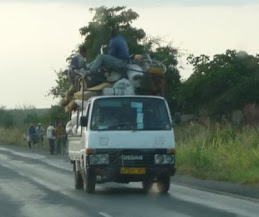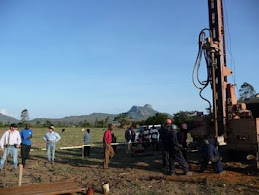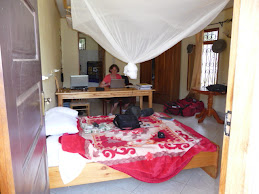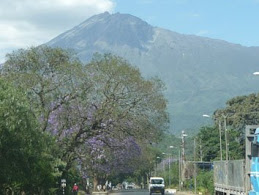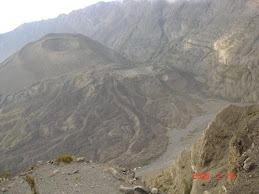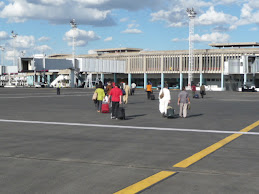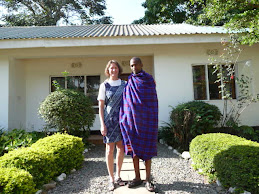5 of us volunteers from Adra climbed into our little Pajero and headed east to the Indian ocean for a few days over New Years eve. It is meant to be a 6 hour drive, but the drive between Arusha and Moshi which is a smaller town 60 km due east took about 2 hours. There were police out in front of every little village stopping virtually every one. There are many villages between Arusha and Moshi. This is their high season and they can supplement their salaries with a lot by stopping and finding things wrong with people’s vehicles then taking unreceipted fines!. We got stopped for not having a copy of the vehicle registration on us. Then we got stopped for not having a ‘fire sticker’. Not having heard of this we ask what is a fire sticker. He points us to a guy sitting in a fire truck donated by the Japanese. Apparently every vehicle is meant to pass a ‘fire certification’ then gets a sticker to put on the windshield. Naturally they don’t have any stickers left but we still have to pay, then with his written temporary receipt, then drive into the government office in Moshi to get an official government receipt to say we had paid for this inspection. No one ever inspected the truck. The government guy in Moshi had no stickers either, he said try again late January. While in Moshi we filled up with fuel and when I opened the petrol cap a wasp flew out and stung my hand. Ouch, it swelled up a bit for three days. That was a lot of drama in 2 hours!
Anyway we get to Pangani with no further incident at about 3 pm after the last 42 km along a dirt road. We checked into the Tinga-Tinga lodge. It is quite basic and rustic on a cliff top overlooking the blue ocean. Very pretty. It is a lot hotter there than Arusha so we quickly head down the steps to the ocean. The water is very warm and fantastic for swimming and just floating about it. Very nice. Dinner is in an open air restaurant with seafood dishes. The full moon is shining on the water in between the palm trees. The next day was New Years eve. We drove to Pangani town itself and walked along the dilapidated water front. It used to be a popular trading center in the early days but has been neglected for about 100 years and so most of the early European style stone buildings are in various stages of decay and collapse. They still have some nostalgic charm. The town got its infamous name from the Swahili verb ‘panga’ which is to arrange. It was a slave trading town and the selling broker would call out ‘Panga Panga’ to get the slaves arranged in a line to be sold. Over the years it became Pangani. New Years eve was with about 30 guests at the lodge, all international travellers of some sort. The lodge put on a special buffet. After eating we moved just outside on to the grass on the cliff top where it was a little cooler. The evening passed quickly with talking to other people, where they came from, why they were in Tanzania. At midnight, out came the champagne for a New Years toast.
New Years day after a morning swim, the lodge manager said he would take us for a walk up the beach to a special beach where there were giant Clam fossils in the sandy cliffs. We were into this with excitement. Taking our swimming gear and water bottle we headed off north around the next bay. Tucked in behind some mangroves was this sandy beach with a 7 m sandy cliff above it. Sure enough there were many of these fossils. Millions of years old they had been calcified and were very heavy. Some almost complete shells and some broken ones. Some protruding just a little suggestively bit from the sand ,others lying exposed on the sand. With storms and high tides they get reburied and others get exposed all the time he said. These shells are about 2 ft (0.6 m) across. Ramona had her picture taken sitting in one. On the way back instead of walking back around the bay I swam across it while Ramona carried our gear. The water is so warm and inviting. The next day after a morning swim we left with fond memories of this secluded beach town.
Tuesday, January 12, 2010
Monday, January 11, 2010
Serengeti Park is Amazing
Serengeti is Maasai for Endless Plains. Tucked in behind the Ngorogoro group of extinct volcanoes, the Ngorogoro Conservation Area abuts against the eastern side of the Serengeti. From there and to a long way west are these vast grassy plains that seem to stretch forever. The difference between the Conservation area and the Serengeti is striking. In the Conservation area the Maasai shepherds are allowed to graze their herds of cows and goats. There the pastures are very short and bare in places. In the Serengeti no domestic grazing is allowed. The grassy plains are thick rich grass. The official entrance is about 20 km inside the park set in a big rock Kopje. Once past that, you drop down to the plains proper and the incredibility of 100,000’s of animals becomes very apparent. Zebras and Wildebeests grazing as far as the eye can see. From the very close that move off the gravel road as the vehicle travels by to just black specs on the far horizon. It is simply staggering to see that much wildlife before your eyes. We’d barely gone 1 km down the road towards the park center and came across a small pride of lions lying out open on the grass. They have few predators if any and so can virtually do what they like when they like. With this much food around for them they do not have to go very far. They barely blinked as we stopped to film them. We camped the first night (Christmas eve)at a public campground near the center of the park. Here there are quite a few trees and bushy with rocky out crops. The guide and cook that came with us from SOK Adventure Travel we had arranged the trip with, looked after putting up the tent and preparing food. We ate in style, huge plate of food with a bottle of wine, though it was shared with a number of large moths who liked our lanterns in the dark. It was a 5:15am start Christmas day as we were going to hot air ballooning at dawn. A driver came to pick us up in the dark (and rain now). The roads that were not gravel had turned into this black super sticky mud and our Landcruiser got stuck. We had to wait for another to come and tow us out. Once at the balloon launch site we waited for the rain to go off, but alas it never did so the balloon was cancelled for that day. They were fully booked for the next days so we thought we had lost the opportunity. Back to the camp ground and the rain stopped. Another huge plate of food and then off for a game spotting drive around the center of the park. There are roads crisscrossing about every ½-1 km so you can get close to most locations. Throughout the grassy plains are small streams with long grass and trees growing along them. This is where the predators seem to spend their time in waiting for the grazing animals to wander close. We spotted another pride of lions not far from our camp. They had killed a zebra the day before and were now standing (actually lying sprawled out)guard over it to keep the vultures from stealing their next two days food. A couple of km further on we saw a group of parked Landcruisers bumper to bumper with tourists leaning out the top, their camera’s with super lens on them pointing in the same direction to some trees. Pulling up in the cluster we spot a cheetah slinking through the long grass. Out come our cameras too. After a while of the traffic jam of too many Landcruisers around we moved further south to a region with less traffic. Another Cheetah was spotted close to our road. She was walking along parallel to the road. Taking her time and stopping every now and then to look around over her shoulder. What a magnificent cat. Unlike the solid muscled lions, the cheetah is almost a cross with a gray hound dog. They are long and sleek, with a large chest and a very small rear with a long thick tail. Purely built for speed. We watched and followed her for quite a while. For a while two jackles (like a fox) came along and joined her. They would follow her about 5 m behind. She didn’t seem to mind too much bet every few mins she would turn around and appear to tell them to get lost. They would run off about 50 m, then when she resumed her course they would come back to behind her again like little kittens. So cute. Leaving the Cheetah and off to some more rock kopjes with trees on to see if there are more cats in them. They use these big rocks as look out points over the plains. Seeing nothing there we moved east over to area where these was a small stream running along. There were quite a few trees with long grass along the depression. There were two other Landcruisers there watching something. We finally saw their target, a Leopard sneaking through the grass making a path along the stream depression. We drove further along crossed over the stream and came back on the other side where the leopard now was. We were about 50 m away from her. She crept along a distance more, then found a tree with a big broken branch sticking out of it a couple of meters above the ground. She leapt up on this near horizontal branch and sat surveying the area. She was paying no attention to any of us at all. The leopard is spotted like a cheetah but has the frame of a small female lion. This was our first leopard we had seen. Beautiful creature and a mighty hunter we are told.
Back to the camp, past the lions guarding their dead zebra, and yet another huge plate of food for a late lunch. We told Amani the cook to cook on smaller plates, he just laughed and trotted off to bring a plate of fruit for dessert. The rain had come back as a drizzle as we started off on a Christmas evening game drive. Past the lions again now with more vultures around sitting in the trees getting soaked with rain. We pass a heard of Cape Buffalo in some trees. These are one of the big five. A massive bull like animal with a dangerous set of curved horns ready to tear into you if they can get you. They are very aggressive we hear and always look at you with an angry appearance. They are impressive to see nevertheless. By now it is getting dark. Our guide and driver Emanuel gets a call from his brother who also is in the park. He is a guide for another group. His Landcruiser has broken down not far from us. We drive over and tow him back to the lodge where his clients are staying then return to our camp in the dark. Amani delivers another huge plate of food with a bottle of red this time. Emanuel with some prompting gives a good lesson in Kiswahili.
5:50 am and our alarm goes off on Boxing day. Emanuel wants us in the Landcruiser by 6 am for an early morning game drive. Back past the lions still hording their food supply from hungry eyes. We drive north stopping for a troop of baboons on the road doing their early morning grooming. Their hand actions are so human like it is fascinating to watch. Then it is on to the Hippo pool. With the recent rain the river was in flood. The hippo pool is at a right angle bend in the river, the water is quite deep and swift with a stillish area at the back of the bend. There are dozens of hippos in there. Snorting and fighting with each other. Quite a racket at times. The size of these massive animals is quite apparent at that close range. Back to the campsite, for yes you guessed it, another huge breakfast. Onto an afternoon game drive, this time down in the south of the park. On the way we got to see several groups of lion sitting in trees and watching what was going on out on the grassy plains. Though not unheard of, lions are not normally in trees. They are a bit awkward crawling around the trees. One tree had two near full grown males in it. Their heads with the mane are so big. Another had two big lioness and two ½ grown cubs all in it. We passed a small water hole with hyenas sitting in the water to cool off. They just peered at us as we pulled up to watch. Quite odd. Further south was away from the grassy plains with significantly less animals we learned after a while. We came across a group of people sitting on top of the Landcruiser drinking wine pointing at a lioness a couple of 100 m away sitting on a rock kopje eyeing them. Their Landcruiser was stuck in a 7 m wide river crossing with steep muddy banks on each side. The water was up to the bottom of the doors. They had been there 3 hours without seeing any one in sight so were glad to see us. Without a long tow rope we could not pull them out and they didn’t appear to want to get dirty to dig themselves out. We tried a piece of short rope our driver had, that only ended up getting us stuck in their too. Not good, late afternoon, no one knows where we are, two stuck Landcruisers and a lion watching it all. We had prepayed several $100 to stay in a game lodge that night and the thought of losing that luxury and having to stay in a Landcruiser in the middle of a muddy water pool was not appealing. With cutting branches with a very blunt machete and digging away the banks we got our Landcruiser out finally. We took their driver with us and dropped him off with a ranger to go back and tow them out properly. We got back to the lodge after dark and in the rain. On the way the Balloon people called our driver and said they had 2 free spots for the next morning and we could go.Another 5:30 am rise to get to the balloon site. It was overcast, no rain and with a gentle breeze to the south. Just before the balloon was ready, the basket was on its side and we were instructed to enter the basket and sit in our seats that were now on their side. Once every one was in their seat, the pilot ignited the burners and filled the balloon with hot air, the balloon picked itself up vertical and the basket rolled the right way up and we were off. The other balloons were a few minutes behind us. We would float anywhere from 10 to 300 m above the ground. There were herds of wildebeest and zebra below us with the occasional hyena skulking across the plain. The balloon burners make a bit of noise when they are on and the wildebeest being very nervous will run off quite readily. The flight was meant to be for an hour but the wind carried us south where there were fewer roads for the support vehicles to meet us, so we stayed aloft as long as we could to get closer to a road, by the time we hit the ground the butane tanks were completely empty and the balloon could travel no more. A great experience with breathtaking views. After that they took us to a nearby set of trees where they had laid out a champagne breakfast for us all. After breakfast it was back to Arusha.
Oldavai Gorge Stop Over
This is in the Ngorogoro Conservation area. This is the site where Mary and Louis Leakey made their famous early man discoveries back in the 1950s. There is a small museum with fossil and stone tool relics. You have lunch on top of the cliff under a shaded roof overlooking the gorge that drops off right below and stretches out for a km of so. A guide gives a lecture on the history of the site while you eat lunch. Their bones were 1.6 million years old. A few km away Mary discovered some human foot prints over a 25 m stretch from two adults and a child (they called 'Lucy'). These prints were 3.6 m years old, but no fossils at that site. At the Oldavai site there are excavations every year by international scholars and finds are common we were told. It may have been an old lake which is why there is so much evidence of previous habitation there.
Back to the camp, past the lions guarding their dead zebra, and yet another huge plate of food for a late lunch. We told Amani the cook to cook on smaller plates, he just laughed and trotted off to bring a plate of fruit for dessert. The rain had come back as a drizzle as we started off on a Christmas evening game drive. Past the lions again now with more vultures around sitting in the trees getting soaked with rain. We pass a heard of Cape Buffalo in some trees. These are one of the big five. A massive bull like animal with a dangerous set of curved horns ready to tear into you if they can get you. They are very aggressive we hear and always look at you with an angry appearance. They are impressive to see nevertheless. By now it is getting dark. Our guide and driver Emanuel gets a call from his brother who also is in the park. He is a guide for another group. His Landcruiser has broken down not far from us. We drive over and tow him back to the lodge where his clients are staying then return to our camp in the dark. Amani delivers another huge plate of food with a bottle of red this time. Emanuel with some prompting gives a good lesson in Kiswahili.
5:50 am and our alarm goes off on Boxing day. Emanuel wants us in the Landcruiser by 6 am for an early morning game drive. Back past the lions still hording their food supply from hungry eyes. We drive north stopping for a troop of baboons on the road doing their early morning grooming. Their hand actions are so human like it is fascinating to watch. Then it is on to the Hippo pool. With the recent rain the river was in flood. The hippo pool is at a right angle bend in the river, the water is quite deep and swift with a stillish area at the back of the bend. There are dozens of hippos in there. Snorting and fighting with each other. Quite a racket at times. The size of these massive animals is quite apparent at that close range. Back to the campsite, for yes you guessed it, another huge breakfast. Onto an afternoon game drive, this time down in the south of the park. On the way we got to see several groups of lion sitting in trees and watching what was going on out on the grassy plains. Though not unheard of, lions are not normally in trees. They are a bit awkward crawling around the trees. One tree had two near full grown males in it. Their heads with the mane are so big. Another had two big lioness and two ½ grown cubs all in it. We passed a small water hole with hyenas sitting in the water to cool off. They just peered at us as we pulled up to watch. Quite odd. Further south was away from the grassy plains with significantly less animals we learned after a while. We came across a group of people sitting on top of the Landcruiser drinking wine pointing at a lioness a couple of 100 m away sitting on a rock kopje eyeing them. Their Landcruiser was stuck in a 7 m wide river crossing with steep muddy banks on each side. The water was up to the bottom of the doors. They had been there 3 hours without seeing any one in sight so were glad to see us. Without a long tow rope we could not pull them out and they didn’t appear to want to get dirty to dig themselves out. We tried a piece of short rope our driver had, that only ended up getting us stuck in their too. Not good, late afternoon, no one knows where we are, two stuck Landcruisers and a lion watching it all. We had prepayed several $100 to stay in a game lodge that night and the thought of losing that luxury and having to stay in a Landcruiser in the middle of a muddy water pool was not appealing. With cutting branches with a very blunt machete and digging away the banks we got our Landcruiser out finally. We took their driver with us and dropped him off with a ranger to go back and tow them out properly. We got back to the lodge after dark and in the rain. On the way the Balloon people called our driver and said they had 2 free spots for the next morning and we could go.Another 5:30 am rise to get to the balloon site. It was overcast, no rain and with a gentle breeze to the south. Just before the balloon was ready, the basket was on its side and we were instructed to enter the basket and sit in our seats that were now on their side. Once every one was in their seat, the pilot ignited the burners and filled the balloon with hot air, the balloon picked itself up vertical and the basket rolled the right way up and we were off. The other balloons were a few minutes behind us. We would float anywhere from 10 to 300 m above the ground. There were herds of wildebeest and zebra below us with the occasional hyena skulking across the plain. The balloon burners make a bit of noise when they are on and the wildebeest being very nervous will run off quite readily. The flight was meant to be for an hour but the wind carried us south where there were fewer roads for the support vehicles to meet us, so we stayed aloft as long as we could to get closer to a road, by the time we hit the ground the butane tanks were completely empty and the balloon could travel no more. A great experience with breathtaking views. After that they took us to a nearby set of trees where they had laid out a champagne breakfast for us all. After breakfast it was back to Arusha.
Oldavai Gorge Stop Over
This is in the Ngorogoro Conservation area. This is the site where Mary and Louis Leakey made their famous early man discoveries back in the 1950s. There is a small museum with fossil and stone tool relics. You have lunch on top of the cliff under a shaded roof overlooking the gorge that drops off right below and stretches out for a km of so. A guide gives a lecture on the history of the site while you eat lunch. Their bones were 1.6 million years old. A few km away Mary discovered some human foot prints over a 25 m stretch from two adults and a child (they called 'Lucy'). These prints were 3.6 m years old, but no fossils at that site. At the Oldavai site there are excavations every year by international scholars and finds are common we were told. It may have been an old lake which is why there is so much evidence of previous habitation there.
Subscribe to:
Comments (Atom)
































































































































